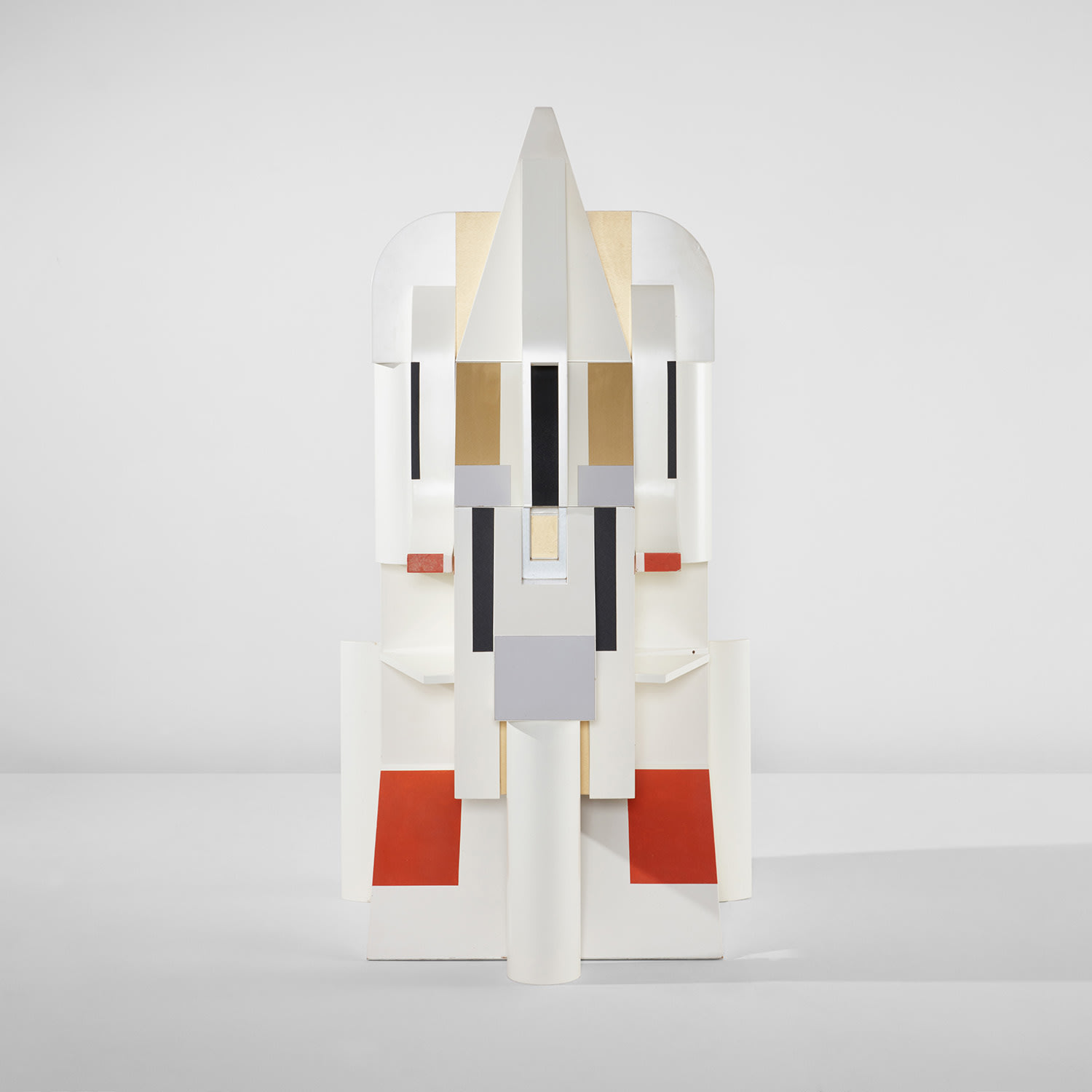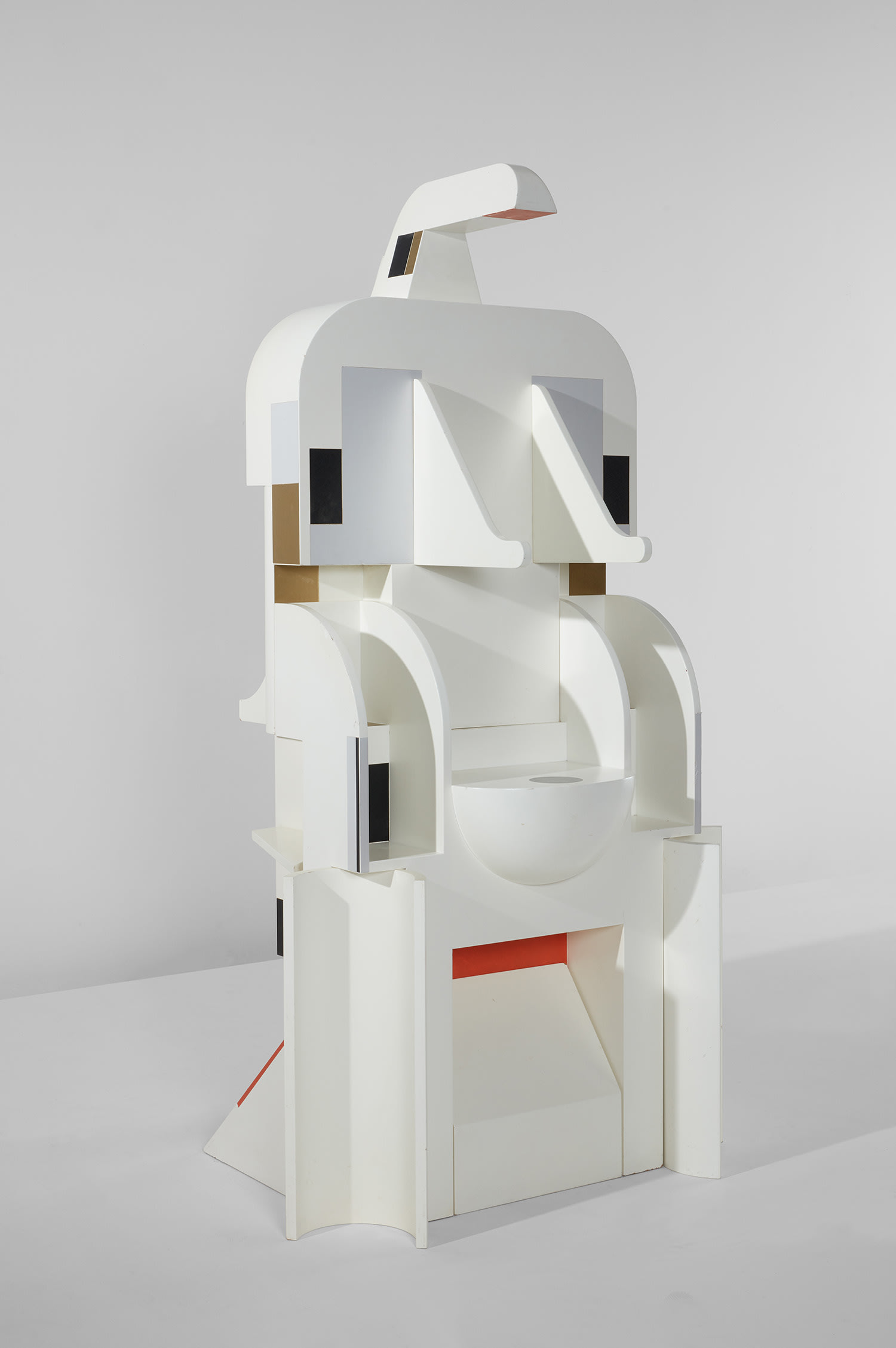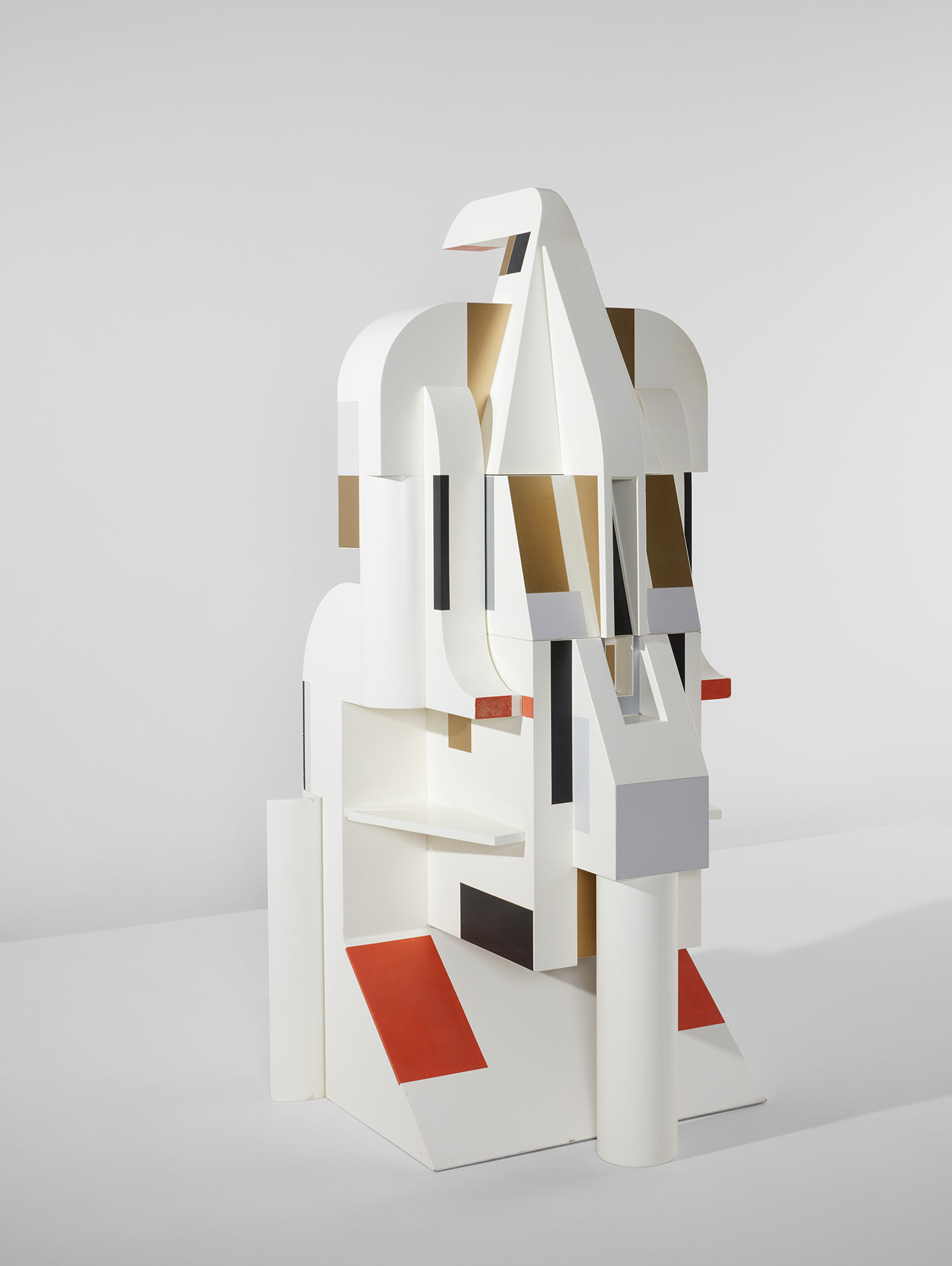







27
Bruno Gregory
Unique "Integrated System (Construction 2)" vanity
1987
Painted fiberboard, painted wood.
76 x 31 1/2 x 42 in. (193 x 80 x 106.7 cm)
Produced for Studio Alchimia, Milan, Italy for the "World Exposition of Ceramic Tile and Bathroom Furnishings," Los Angeles, May 6-8, 1987.
Full-Cataloguing
In April 1987, Interior Design magazine advertised the inaugural “World Exposition of Ceramic Tile & Bathroom Furnishings” in Los Angeles, saying, “discover international bathroom fixtures: vanities, sanitary ware, faucets, and bathtub and shower enclosures and fixtures from the world’s most innovative sources.” Though visitors to the exhibition saw new and state-of-the-art bathroom appliances and floor coverings from over 600 international exhibitors, it is unlikely that the crowd witnessed anything quite as radical as the “Imaginary Bathroom” organized by the avant-garde Italian design collective Studio Alchimia. This “Imaginary Bathroom” included the present vanity designed by Bruno Gregory as well as a shower designed by the group’s co-founder Alessandro Guerriero, a sink designed by Giorgio Gregori, and a sculpture by Alessandro Mendini. This display was Studio Alchimia’s first showing on the west coast of the United States, and, in typical fashion, the group’s designs were more polemical than practical. The Expo was intended to educate architects and designers as well as professionals in sales, manufacturing, and construction about the latest market trends. Bruno Gregory and the rest of Studio Alchimia, however, were more interested in proposing a new way of life—that is, a bathroom for the future.
Between 1986 and 1987, Gregory created a series of five Constructions. The present lot is his second iteration of this project. Formally and aesthetically, all of these Constructions drew on the art and design movement Futurism as well as emerging computer technologies of the 1980s. Italian Futurism was an early 20th-century art and design movement that demanded a radically new and restructured world by means of technology, machines, speed, and even violence. Artists such as Filippo Tommaso Marinetti, Umberto Boccioni, and Fortunato Depero advocated for industrialization, a liberation from the weight of the past, and—as the name suggests—a look towards the future. Artistically, their style drew from Cubism and often included riots of color and sharp, angular forms. The arrangement of geometric volumes in Gregory’s design seem to reference some of the architectural and artistic projects from this earlier period. Like Umberto Boccioni’s Unique Forms of Continuity in Space, the vanity’s form seems to morph when viewed from different angles. The complexity of this arrangement of geometric forms is elevated by the silver, gold, black, and orange panels interspersed throughout the design.
Bruno Gregory was not only looking back to this design period but also towards the future. He looked at the early graphic and videos capabilities of computers of the 1980s, and he wanted to create “compositions like the sequences of images of a kaleidoscope.” He began this experiment by designing a collection of rugs, the designs for which visually referenced the appearance of overlapping images on a computer screen. He then wanted to bring this graphic experiment to three dimensions. Gregory began with a set of geometric figures that he then arranged in various, seemingly precarious arrangements. Some of these shapes formed hooks, drawers, and even a basin, while others are purely aesthetic. There is a robotic and machine-like quality to the vanity that contradicts its largely sculptural, rather than utilitarian, nature. This sense of contradiction is heightened by the feeling that, despite its formidable presence, the vanity could suddenly topple over. Describing this dialectic, the designer said, “The final balance of masses and details in the composition takes place only a moment before the possible final collapse of all the elements put into play.” It is this duality and surprise that makes the present lot so compelling today and still such a groundbreaking example of Italian design.
Between 1986 and 1987, Gregory created a series of five Constructions. The present lot is his second iteration of this project. Formally and aesthetically, all of these Constructions drew on the art and design movement Futurism as well as emerging computer technologies of the 1980s. Italian Futurism was an early 20th-century art and design movement that demanded a radically new and restructured world by means of technology, machines, speed, and even violence. Artists such as Filippo Tommaso Marinetti, Umberto Boccioni, and Fortunato Depero advocated for industrialization, a liberation from the weight of the past, and—as the name suggests—a look towards the future. Artistically, their style drew from Cubism and often included riots of color and sharp, angular forms. The arrangement of geometric volumes in Gregory’s design seem to reference some of the architectural and artistic projects from this earlier period. Like Umberto Boccioni’s Unique Forms of Continuity in Space, the vanity’s form seems to morph when viewed from different angles. The complexity of this arrangement of geometric forms is elevated by the silver, gold, black, and orange panels interspersed throughout the design.
Bruno Gregory was not only looking back to this design period but also towards the future. He looked at the early graphic and videos capabilities of computers of the 1980s, and he wanted to create “compositions like the sequences of images of a kaleidoscope.” He began this experiment by designing a collection of rugs, the designs for which visually referenced the appearance of overlapping images on a computer screen. He then wanted to bring this graphic experiment to three dimensions. Gregory began with a set of geometric figures that he then arranged in various, seemingly precarious arrangements. Some of these shapes formed hooks, drawers, and even a basin, while others are purely aesthetic. There is a robotic and machine-like quality to the vanity that contradicts its largely sculptural, rather than utilitarian, nature. This sense of contradiction is heightened by the feeling that, despite its formidable presence, the vanity could suddenly topple over. Describing this dialectic, the designer said, “The final balance of masses and details in the composition takes place only a moment before the possible final collapse of all the elements put into play.” It is this duality and surprise that makes the present lot so compelling today and still such a groundbreaking example of Italian design.